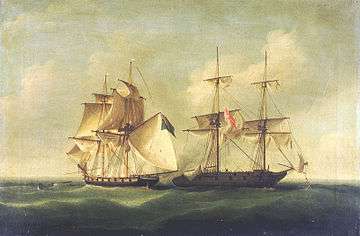Action of 2 March 1808
The Action of 2 March 1808 was a minor naval battle between the Royal Navy's 18-gun Cruizer-class brig-sloop HMS Sappho, and the 28-gun, Danish two-decker brig Admiral Yawl, during the Gunboat War. Sappho, under the command of Captain George Langford, discovered and chased Admiral Yawl, which was steering a course in order to cut off several merchant vessels to leeward. After a short engagement Sappho captured the Admiral Yawl, commanded by Jørgen Jørgensen.[1]
Admiral Yawl appears in references under a variety of names including Admiral Yorol and Admiral Juul.
Background
On 2 March, Sappho was cruising off Scarborough when she discovered an armed brig that was steering a course as if intending to cut off several merchant vessels to leeward.[2] Sappho gave chase and at about 1330 hours fired a shot over the brig, which was showing British colours. Substituting Danish for British colours, which she had previously hoisted to deceive Sappho, the Danish vessel responded by firing her broadside.[2] Langford immediately bore down and brought what turned out to be the Admiral Yawl to close action. The engagement lasted about half an hour before Admiral Yawl struck her colours.[2]
Battle
Sappho carried sixteen 32-pounder carronades and two 6-pounder guns, manned by a crew of 120 men and boys. Admiral Yawl was a brig, but unusual in that she had her armament on two decks; on her first or lower deck, she had twelve 18-pounder carronades and on her second, or principal deck, she carried sixteen 6-pounder guns.[2] Her crew consisted of 83 men and boys.[3] The weight of the broadsides favored Sappho at 262 pounds versus 156 pounds for the Admiral Yawl, as did the relative size of the crews. In the engagement, Sappho had one man wounded and one man injured. Admiral Yawl had two dead: her second officer and a seaman.[3] As a result of the action, Langford received promotion to post-captain, and in 1847 the Admiralty issued the Naval general Service Medal with the clasp "Sappho 2 March 1808" to all surviving claimants from the action.[4]
Aftermath
The Danish captain was the colourful and erratic adventurer Jørgen Jørgensen, who in 1801 had been a member of the crew, and perhaps second in command, of Lady Nelson. On Lady Nelson, he participated in at least one voyage of exploration along the coast of Australia. In his autobiography, he states that his father joined seven other merchants from Copenhagen jointly to purchase the Admiral Yawl and present it to the Danish Crown.[5] The Government commissioned, manned, and armed Admiral Yawl.[Note 1] Jorgenson reported that by cutting through the ice a month before it was expected that any vessel could get out, he was able to come unawares among the British traders and capture eight or nine merchant vessels before Sappho put an end to his cruise.[5]
Notes
- It is not clear from this account whether she was a privateer or a naval vessel.
References
- Citations
- James/Chamier p.21
- "No. 16124". The London Gazette. 1 March 1808. p. 321.
- The Gentleman's magazine, (March 1808) Volume 98, Part 1, p.249.
- "No. 20939". The London Gazette. 26 January 1849. p. 241.
- s:The Convict King The Convict King.
- Bibliography
- James, William; Chamier, Frederick (1837). The naval history of Great Britain: from the declaration of war by France in 1793 to the accession of George IV. 3. London: R. Bentley.
